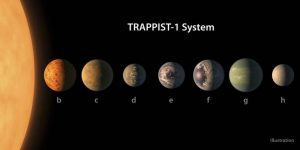A Fantastic Time For Discovery, and for SETI
by Carl Kruse
The journal NATURE’s website reportedly crashed after it announced the NASA discovery of seven Earth-like planets orbiting a star near us, some 40 light years away in the Aquarius constellation.
The star known as TRAPPIST-1 was observed by a Belgian research team with data collected from NASA’s space-based Spitzer telescope .

This graphic provided by NASA/JPL-Caltech shows an artist’s illustration of what the TRAPPIST-1 planet system might look like. The planets circle about the dwarf star Trappist-1, about the size of Jupiter. Three are in the so-called Goldilocks zone, where liquid water and, possibly life, could exist. The others are right on the doorstep.
Three of the seven planets are in the “Goldilocks” range, or possibly habitable, as they are the right distance from the star so that liquid water could exist on the surface. That gives the star system the record for the largest number of goldilocks-zone planets found orbiting a single star. TRAPPIST-1 is a dwarf star and will continue to burn for trillions of years, potentially more than enough time for life to develop, especially on those planets in the habitable zone.
Our Milky Way is 100,000 light years wide, the visible universe billions of light years in every direction, and so a distance of 40 light years makes TRAPPIST-1 our cosmic neighbor.
Twenty years ago we didn’t know there were planets outside the solar system. Now, every day, seemingly everywhere, we find new planets, including some with Earth-like qualities. Is it just a matter of time before we find a planet, or many planets, where what happened on Earth — the rise of life and intelligence, also happened there?
We live in times where too often fall short of our full potential. It is during these times that the joy of discovery never smelled sweeter.
Carl Kruse
https://carlkruse.org
Contact Carl Kruse : carl AT carlkruse DOT org
P.S. With the wave of exoplanet discoveries, especially of Earth analogues, it’s a beautiful time for SETI. Check out the former blog posts regarding the Search for Extraterrestrial Intelligence:

This is seriously fantastic news Mr Kruse. Looks like there just might be ALOT more earth analogues out there than anyone imagined.
It sure does look that way.
Carl Kruse
Could the next Earth, meaning full of intelligent life, etc, soon be found?
Many of us are hoping so! 🙂
Carl Kruse
More exoplanets have been discovered since this blog post. Such an exciting time for exo planetary discovery.
Carl Kruse
For those interested in SETI also find me over at the SETI website: https://setiathome.berkeley.edu/view_profile.php?userid=320219
Cheers!
Carl Kruse
I’m late to comment, but my guess is there are many more exoplanets being discovered every day as scientists scour through the data from Kepler and other observations. Exciting times.
Exciting times for sure Tam. Could it be long now before we can conclusively answer the question, “are we alone?”
– Carl Kruse